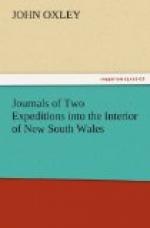June 16.—Our day’s route was as usual over a very flat though rich country, thickly wooded with good timber of the eucalyptus and angophora species, with some fine cypresses in the looser soils, and back from the river. The country, although flat, appears considerably elevated, and is neither flooded nor swampy; the opposite side apparently of the same kind. We fell in with another small camp of natives; the women and children withdrew before we came up with them: among the men (seven in number) we recognised four whom we had seen on the last expedition at Mary’s Rivulet; the recognition was mutual, and they seemed highly pleased with it: they accompanied us about eight miles farther to our evening’s encampment, where being gratified with some kangaroo, and undergoing the operation of shaving, (at their earnest request, after seeing one of their number disencumbered of an immense beard) they left us at sunset to join their families, which were probably at no great distance. About four miles above our encampment, on the immediate banks of the river, we discovered a large mass of saponaceous earth; I at first took it to be a fine pipeclay, but on examination, it appears to possess all the valuable qualities of fuller’s earth; and a piece of woollen cloth being partially greased, and then rubbed over with the earth, the grease was perfectly extracted and the cloth left entirely clean. Among this earth, small white pieces of a hard marly substance were found, and appeared either to be pure lime, or to contain a very considerable portion of it. On one of the beaches a small shell was found, which was unanimously adjudged to be a marine production; at least, we had never before seen any fresh-water shell resembling it. The river fell during the last night and the course of this day very considerably, and is, I think, below its proper level; there is however an ample sufficiency of water for our boats: the chief dangers are from stumps and branches of trees in the narrows; and what previously to the great fall in the water we could have passed over without difficulty, now occasions us some anxiety and trouble. The course the river took to-day was considerably to the north.
June 17.—A very severe frost, the ice a quarter of an inch thick. About a mile down the river, we saw a native burial-place or tomb, not more than a month old; the characters carved on the trees were quite fresh: the tomb had no semicircular seats, but in other respects was similar to those seen on our last journey. The country still continued perfectly level, the greater part extremely good and rich; back from the river it was occasionally marshy, with barren rocky scrubs; the timber large, and generally good: we could not see beyond a mile on the opposite side, but the country there appeared much the same. One of the men, who was some distance ahead of the horses, saw a large party of the natives, who fled at his approach, and swam the river; there were upwards




